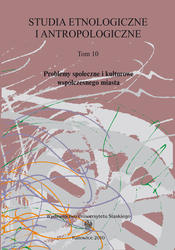

The subject of reflection constitutes the condition of the traditional heritage of the peasant’s culture and its place in the contemporary culture of Częstochowa. In the space of this city, the trend for the folk character, going beyond not only the sphere of the advertisement of public life, but also permeating into the family tradition and traditional behaviours has been recently recognised. For example, The Days of The European Folk Culture connected with Jasna Góra Harvest Festival, the National Farm Exhibition, the National Contest of the Folk Art, presentation of the national and foreign folk bands, shows of the works of folk authors, taking into account the “dying professions”, as well as a sale of regional products, the agricultural produce, farm preserves, take place during the first September weekend from the initiative of the Gaude Mater Culture Promotion Centre. A large popularity in the urban environment is ascribed to the so called peasant (homemade) buffets prepared for the second day of the wedding, Fresh pickled cucumbers with a dill, lard with pork scratchings, a traditional ham with a bone, rural paste, brawn, black, a round loaf of bread and even spirit samogon are served at that time. Decorations of the surrounding are made of the attributes commonly associated with a village, such as a plait of garlic or onion, a cluster of dried herbs and mushrooms. Also, the appropriate containers in the form of stone small barrels, clay bowls and plates, ceramic containers, wooden scoops and chopping boards are used. The inhabitants of the city, used to live in rural conditions, are willing to go to distant places, folk stylized hotels and restaurants in which they can find a substitute of ruralness. Waiters wearing pseudo folk clothes serve there the dishes of regional cuisine. Everything takes place in rustic interiors, the sounds of melody and folk songs recorded or played alive by the folk bands and groups. The very stylizations are usually the effect of the owner’s or designer’s vision. They most often constitute a mixture of the elements borrowed from the culture of different regions (most often from Podhale) or the adaptation of the elements of the culture of another, often distant, region. In such a situation the questions on the nature of such actions arise. Is the permeation of given rustic elements into the urban space the result of the dynamics of the social awareness, filled with values deeply rooted in the culture of the countryside, also the attempt to continue the tradition or the a reflection of a temporary trend promoted on the series of commercial actions? The author of the article made an attempt to analyse the place of the urban cultural heritage in the contemporary urban environment.
Download files
Citation rules

Vol. 10 (2010)
Published:
 10.31261/SEIA
10.31261/SEIA